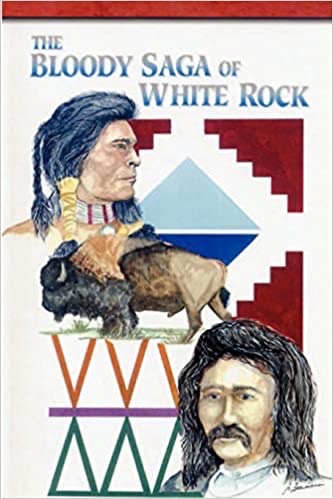If Roy V. Alleman had never written The Bloody Saga of White Rock, the thought of looking into the life of Thomas Lovewell and other members of his family would never have occurred to me.

Alleman's book is quite readable and lively, with a frenzy of bloodletting that lives up to the title. A friend who borrowed my copy several years ago lamented, “When the settlers first arrive the Indians kill so many of them, and then when the Indians leave the area the settlers start killing each other.”
Besides being well documented, nearly all of the mayhem described in the book really did involve Thomas Lovewell and his wife Orel Jane, who lost friends and neighbors in what was called the “Jewell County Massacre” a year after arriving in Kansas. A few months later Orel Jane’s father and a companion were ambushed by peddlers who mistook them for rivals. A relentless search for the culprits and a notorious lynching followed soon after.
When I described the aforementioned “massacre” to a coworker, he thought the term might be unwarranted, being unimpressed by the body-count of four dead, one wounded, and one missing, until I explained that the toll accounted for about a third of the population of the county at that time. “Jewell County Massacre!” was the headline in the press of the day, and to fleeing survivors it must have rung true.
Determined settlers, joined by a new influx of immigrants, would be besieged, harried and picked off by vengeful Plains warriors over the next two years.
The personal history of the Lovewells recounted in Bloody Saga is not so far off base overall, but chock full of little missteps that eventually start to add up. Thomas left his family behind for a sojourn in the Far West that lasted six years, not sixteen as the legend states. He rode away in 1859 instead of 1849. Hist first wife Nancy did not die during his absence, but in fact filed for divorce.
Thomas’s second wife, Orel Jane (Davis) Moore, was not Nancy’s sister, but her niece, sixteen years younger than her new husband. The pair did not tie the knot in a church wedding worthy of a special episode of Little House On the Prairie, before setting out for Kansas, nor did they bother filling out a license or reciting vows. Shortly after crossing into Kansas along their trek toward the Republic River valley, they began living together as man and wife. It was an informal union that would endure until Thomas’s death fifty-four years later.
Late in Alleman’s book, years after the birth of Thomas and Orel Jane’s last child, Thomas receives an urgent message from his long-lost daughter Julany, last seen waving goodbye to him when he rode off to Pikes Peak. She had married a man named McCaul who suffered a fatal injury while working on the St. Louis Depot. She was ill with six children to look after and desperately needed help.
Julany had sent the message in care of the Postmaster at Lovewell, hopeful that the little town in Kansas might have something to do with her father. Boarding the next eastbound train with connections for St. Louis, Thomas scooped up the family and brought them to Lovewell. Later, according to Alleman, Julany would marry a man named John Robinson. Here’s where my interest was piqued, because Julany would have one last child, Lilly Robinson, my grandmother.
I remember thinking as I read the book that I would never be able to learn any significant details about the poor, mysterious Mr. McCaul, whose story was surely lost to history after so many years. It finally occurred to me that Edward McCaul’s daughter, Alice McCaul, was my family’s beloved Aunt Alice from Fort Smith. Maybe it hadn’t been so many years after all.
It later transpired that not all of the six children Julany was caring for were her own, but among those that were, was my grandmother Lillie Robinson who had been brought to Lovewell with the rest. Julany’s matrimonial history was more complicated than it first appeared to be. In fact, I’m still sorting it out.
I would even learn a few solid facts about Edward McCaul, who had been a successful businessman in Carbondale, Kansas, until he was driven out of town for being an obstinate bootlegger in a dry state that had begun cracking down. He headed for San Francisco in search of new opportunities, and then somehow ended up as a carpenter in St. Louis, where he would die in a railroad hospital only six weeks before Julany died of cancer at Lovewell.
In short, everything on this site started with Roy Alleman’s book, and with the realization that while he mostly told the truth about Thomas Lovewell, his adventures and his family, he did not tell the whole truth and nothing but the truth.
If he had, there would have been nothing for me to add. I’ve spent much of the last decade doing just that.
Mr. Alleman died in 1999 at the age of 90, four years after publishing The Bloody Saga of White Rock. If he had waited to get all the facts right, he never would have finished it.